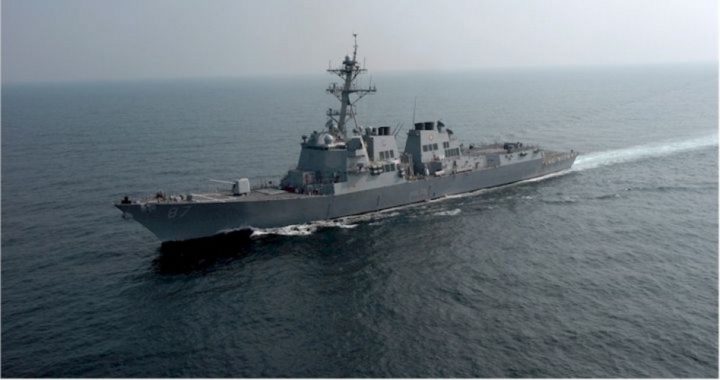
The U.S. Navy announced on October 10 that two missiles fired from rebel-held territory in Yemen landed near the USS Mason (shown), a guided missile destroyer sailing off Yemen’s coast in the Red Sea. Ian McConnaughey, a spokesman for U.S. Navy Forces Central Command, said that it is unclear if the Mason was specifically targeted, though both missiles were fired in its direction over an hour’s time period.
“We assess the missiles were launched from Houthi-controlled territory in Yemen,” UPI quoted Captain Jeff Davis, a spokesman for the Pentagon, as saying. “The United States remains committed to ensuring freedom of navigation everywhere in the world, and we will continue to take all necessary steps to ensure the safety of our ships and our service members.”
The Houthi group (officially called Ansar Allah, “Supporters of God”) was named after its now-deceased founder, Badreddin al-Houthi. It operates in Yemen, where it has gained control of the country’s capital city Sana’a and its parliament. Houthi was founded in response to the U.S.-led invasion of Iraq in 2003 and is linked to al-Qaeda. It is now led by Abdul-Malik al-Houthi. The Houthis are admirers of Iran’s Ayatollah Khomeini, who led the 1979 revolution against the Shah, and receive military aid from Iran.
We reported last year that the carrier USS Theodore Roosevelt and the guided-missile cruiser USS Normandy left the Persian Gulf on April 19, 2015, joining 10 other U.S. naval vessels off the coast of Yemen in the same general area as today’s attack against the Mason. According to a Pentagon statement at the time, the mission of the ships was to protect the region’s vital shipping lanes. But unnamed White House officials cited by the Christian Science Monitor said that the ships were prepared to intercept any Iranian vessels carrying weapons to the Houthi rebels.
A Navy official confirmed to Fox News at the time that the two warships were being sent to the area off Yemen to help enforce a UN arms embargo and blockade against the Houthi rebels ordered by UN Security Council resolution, passed on April 13, 2015. Among the intended targets of the blockade were a convoy of about eight Iranian ships headed toward Yemen and possibly carrying arms intended for the Houthis. CNN reported that U.S. ships do not have authority to forcibly board Iranian-flagged ships. However, vessels from Saudi Arabia, Egypt, and other “partner nations” were prepared to board Iranian vessels if they entered into Yemeni territorial waters.
The Houthi are fighting against forces loyal to Yemen’s nominal president, Abd-Rabbu Mansour Hadi, a U.S.-supported leader who fled the country in March of 2015 and is currently in Saudi Arabia.
The Houthi and Saudis have traded attacks in recent weeks, with a Saudi air strike on a funeral hall in the Yemeni capital Sana’a on October 8 killing more than 140 people. Two days later, a missile fired from Yemen targeted an air base near the Muslim holy city of Mecca in Saudi Arabia, which was the deepest strike into Saudi territory by the Houthis and their allies.
As we noted in our article last year, U.S. interventionism in Yemen has not been any more productive than was our nation’s long history of intervention in Iran — the country that we are now trying to keep away from supplying rebels in Yemen.
U.S. interventionism in the Middle East continues to haunt us, as the Iranian-backed Houthi rebels and the U.S.-backed forces in Yemen loyal to Hadi square off against each other.
Related articles:
U.S. Fleet to Intercept Iranian Ships Bound for Yemen
Keeping Track of Militant Islamic Groups



